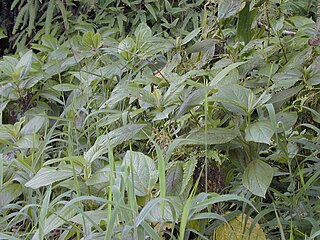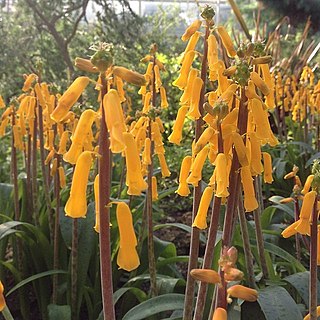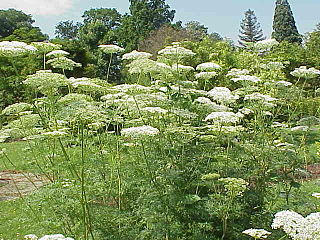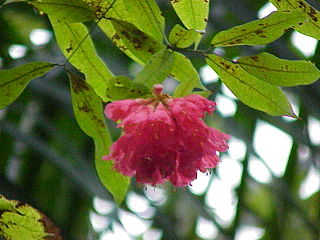
Morinda is a genus of flowering plants in the madder family, Rubiaceae. The generic name is derived from the Latin words morus "mulberry", from the appearance of the fruits, and indica, meaning "of India".

Boehmeria is a genus of 47 species of flowering plants in the nettle family Urticaceae. Of the species, 33 are indigenous to the Old World and 14 to the New World; no species is indigenous to both the Old and New Worlds. The species include herbaceous perennials, shrubs and small trees. Although related to the similar-looking species of the stinging nettles of genus Urtica, species of Boehmeria do not have stinging hairs. Because of the similarity in appearance, some species are commonly called "false nettles".

Libidibia coriaria, synonym Caesalpinia coriaria, is a leguminous tree or large shrub native to the Caribbean, Central America, Mexico, and northern and western South America. Common names include divi-divi, cascalote, guaracabuya, guatapana, nacascol, tan yong, and watapana (Aruba).

Mesembryanthemum is a genus of flowering plants in the family Aizoaceae, indigenous to southern Africa. As with many members of that family, it is characterized by long-lasting flower heads. Flowers of Mesembryanthemum protect their gametes from night-time dews or frosts but open in sunlight. There is an obvious evolutionary advantage to doing this; where sun, dew, frost, wind or predators are likely to damage exposed reproductive organs, closing may be advantageous during times when flowers are unlikely to attract pollinators.

Lachenalia is a genus of bulbous perennial plants in the family Asparagaceae, subfamily Scilloideae, which are usually found in Namibia and South Africa. Most of them have a dormancy period, but new roots will always grow every year.

Astronium is a genus of flowering plants in the cashew family, Anacardiaceae. It is native to Central and South America.

Portulacaria is a genus of succulent plant, classified in its own subfamily Portulacarioideae in the family Didiereaceae. It is indigenous to southern Africa.

Cnidium is a genus of flowering plants in the family Apiaceae, native to Eurasia and North America.

Brownea is a genus of flowering plants in the pea family (Fabaceae), subfamily Detarioideae. The genus includes about 22 species native to tropical regions of the Americas. The species are shrubs and trees growing to 20 m tall. Species range from Honduras through southern Central America and northern South America to Peru and northern Brazil, and to Trinidad and Tobago and the Windward Islands in the Caribbean. Species are typically understorey trees or shrubs in lowland tropical rain forest.

Memecylon is a plant group in Melastomataceae. It consists of 350-400 species of small to medium-sized trees and shrubs occurring in the Old World tropics. Memecylon is a monophyletic group basal to the Melastomataceae clade. Memecylon taxa have more than 600 published basionyms. Diversity of this group is concentrated in tropical Africa, Madagascar, Sri Lanka, India and Malaysia.

Wulfenia is a plant genus in the family Plantaginaceae. The genus was named after Franz Xaver von Wulfen (1728–1805), an Austrian botanist, zoologist, mineralogist, alpinist, and Jesuit priest. It was first described in 1781 by Nikolaus Joseph von Jacquin in. It is also in Tribe Veroniceae.

Helicteres is a genus of flowering plants in the family Malvaceae. Its range is from tropical and sub-tropical Asia through to northern Australia, and also Mexico through to the northern half of South America.
Dilophotriche is a genus of West African plants in the grass family.

Portlandia is a genus of flowering plants in the coffee family, Rubiaceae. Members of the genus are endemic to Jamaica.
Morisonia is a genus of flowering plants in the family Capparaceae, found across the Americas from the United States to Argentina. They are typically shrubs or small trees. The genus was recently enlarged with New World Capparis species due to existing taxonomic instability.
Antherotoma is a genus of flowering plants belonging to the family Melastomataceae.
Calvoa is a genus of flowering plants belonging to the family Melastomataceae.
Cincinnobotrys is a genus of flowering plants belonging to the family Melastomataceae.
Rousseauxia is a genus of flowering plants belonging to the family Melastomataceae.

Pterocarpus officinalis, the dragonsblood tree, is a species of flowering plant in the family Fabaceae, native to southern Mexico, Central America, the Caribbean, and northern South America. It is typically found in coastal freshwater or slightly brackish habitats, in association with mangroves that occupy the more saline areas. Its timber is commercially traded.














